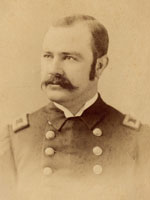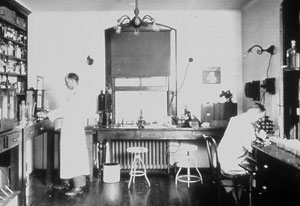NIH marks 125th anniversary with tribute to founder Dr Joseph J Kinyoun
July / August 2012 | Volume 11, Issue 4

Photo courtesy of
Joseph Kinyoun Houts, Jr.
Dr. Joseph James Kinyoun
around the time of his 1886
entry on active duty in the
Marine-Hospital Service.
As NIH marks its 125th anniversary in August, the agency is remembering its founder and humble beginnings as a one-person, one-room "Hygienic Laboratory" on New York's Staten Island.
Dr. Joseph J. Kinyoun, an early pioneer of international research collaborations and a key figure in the annals of medicine, is not widely known today. As a physician in the Marine-Hospital Service (MHS) - the precursor of today's U.S. Public Health Service - Kinyoun founded the Hygienic Laboratory in 1887 to diagnose cholera, plague, smallpox and other infectious diseases prevalent among immigrants seeking to enter the U.S.
In this modest facility, Kinyoun laid the foundation for what today are 27 institutes and centers of the National Institutes of Health. However, few people recognize Kinyoun's legendary contributions or the hardships he endured as a result of his work. In a review published recently in the journal mBio, two NIH researchers aim to change that.
"Dr. Joseph Kinyoun was a central character in shaping the medical research enterprise of today," said Dr. Anthony S. Fauci, co-author and director of the NIH's National Institute of Allergy and Infectious Diseases (NIAID). "Before disciplines such as microbiology and epidemiology emerged, Kinyoun used his ingenuity to discover creative ways to save lives and improve health."
Co-author Dr. David M. Morens, an epidemiologist and senior adviser to Fauci, led the effort to dig into the historical record to uncover previously untold stories that enrich Kinyoun's legacy.
As a 16-year-old boy from Missouri, Kinyoun began to study medicine with his physician father, a general practitioner, according to the article. He eventually graduated from New York's Bellevue Hospital Medical College, where he met others who would become leaders in microbiology and infectious disease. Following post-graduate studies, he spent several years lecturing, conducting research and practicing medicine. In 1886, he qualified to join the MHS and was offered a position to establish the first federal bacteriology lab at Staten Island's quarantine station. During his career, he witnessed the emergence and growth of microbiology and epidemiology and the expansion of U.S. public health activities.

Photo courtesy of the National Cancer Institute/NIH
In 1887, Dr. Joseph Kinyoun set up his one-room
Hygienic Laboratory on Staten Island, New York, to
research cholera and other infectious diseases.
This was in the early beginnings of what is now the NIH.
During the 12 years he directed the MHS lab, Kinyoun followed closely the rapid breakthroughs in microbiology, traveling to Berlin to collaborate on tuberculosis studies and visiting Louis Pasteur's lab in Paris to learn how to produce the rabies vaccine, among other things. Kinyoun brought new reagents, techniques, protocols and ideas back to the Hygienic Laboratory, which by then had been moved to Washington, D.C. His international research partnerships included studies of the recently identified plague bacillus, the diphtheria antitoxin and other novel biological agents.
In 1899, Kinyoun was abruptly reassigned to San Francisco to prepare for the anticipated - and much feared - emergence of plague in the U.S. Instead, he became a scapegoat, the article's authors recount. From the start, Kinyoun met resistance from business leaders and politicians, who were concerned that federal interference would hurt the economy and stir up public fear. For two years, Kinyoun headed efforts to improve sanitation, prepare quarantines and minimize the potential for the spread of plague. When he confirmed the first case in California in March 1900, the governor alleged that Kinyoun fabricated the information, legislators called for his hanging and local residents fought against quarantines. Two months later, with 11 plague cases confirmed and many more suspected, Kinyoun, with the support of President William McKinley, declared an epidemic. Opponents placed a bounty on Kinyoun's life, forcing him to carry a loaded pistol for self-protection.
Kinyoun had many opportunities to fight his detractors and clear his name, but instead he remained patient, continued his work - sometimes under an alias - and eventually was exonerated. By 1904, 121 people in San Francisco had been diagnosed with plague and nearly all of them had died.
"We should never forget the perspective that Kinyoun brought to the role of scientist: a sense of wonder and the pursuit of substantive answers," said Morens.
More Information
To view Adobe PDF files,
download current, free accessible plug-ins from Adobe's website.